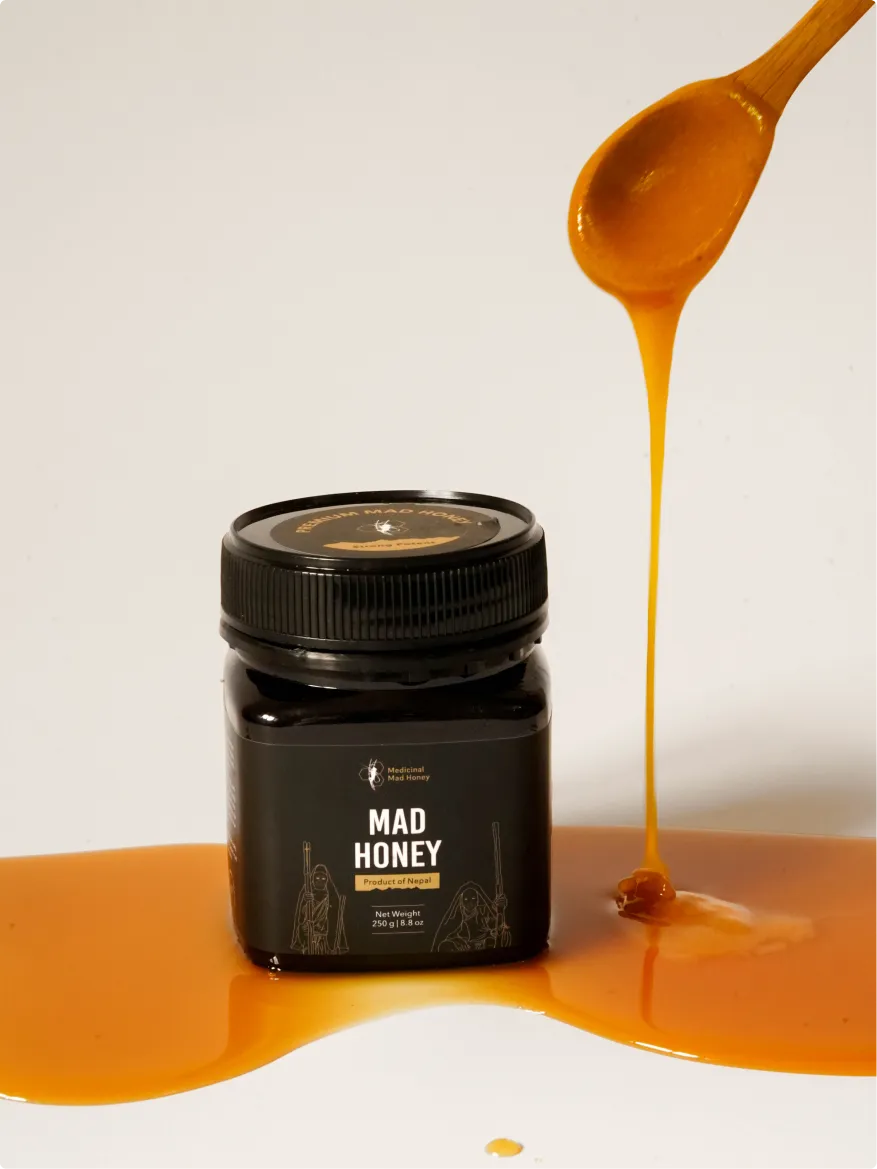The trend of superfoods is ever-rising and two rarest varieties, Red Honey and Wild Honey stand out as exotic ones for health benefits. Both of these products are pure natural bliss- more than just sweetness, these honeys are packed with unique healing properties, deep cultural traditions, and a taste of nature at its wildest.
But with increasing demand comes imitation. Knowing how to identify and purchase authentic red or wild honey-both online and locally-is essential for reaping the benefits of these rare treasures.
What Is Red Honey?
Red honey is a rare and exotic honey, and its name has everything to do with its distinctive reddish color. A specific kind of mad honey that's exclusively generated from high-altitude rhododendron flowers, it is only produced in the Himalayas, at altitudes above 3,000 meters.
Red honey is harvested only at limited times, making its annual production rare and extremely prized. Its wellness-supporting properties impart various benefits making it a natural aid for overall wellbeing.
Benefits:
-
A remedy to relieve pain
-
Can help with cold, cough, and respiratory issues
-
Supports digestion and gut health
-
Has mild sedative offering stress-relieving effects
-
Full of antioxidants and antimicrobial compounds
What is Wild Honey?
Wild honey has a different origin; it comes from the areas that are untouched by human activities, simply true to its name, collected from wild, natural environments. The flower type here is not limited and the color is also not confined; its color can range anywhere from light golden to dark amber, similar to regular honey.
Benefits:
-
For healing coughs/ sore throats as it strengthens the immune system
-
Has natural enzymes, pollen, and nutrients
-
Provides protection against infections
-
Healing wounds and improving skin
-
Acts as a natural energy booster
-
May reduce seasonal allergies due to local pollen
Recommended Read : The Himalayan Giant Honey Bees (Apis Laboriosa)
Identifying Authentic Red/ Wild Honey

Both being rare types, consumers need to be informed about the real types in order to truly benefit from all their properties. The points to consider while purchasing any of these two options are listed here:
Price:
As both the honey formation and the harvesting process require intense and intricate efforts, it’s obvious that these products are priced higher than regular honey and the cheap ones available in the market are what you need to be cautious about.
Color:
Though there is no specific requisite for wild honey, red honey must meet the criteria of having a deep shade of red.
Taste:
Similar to normal honey, both honey types have a naturally sweet base. Some differences do exist; expect red honey to have a slightly bitter or tangy undertone and wild honey to have varying tastes depending on the wildflower variety available in the collection area.
How To Buy
Besides the criteria of authenticity of the honey listed above, it’s also important to buy from a trusted brand. Only buy from sellers that provide:
-
Certificate of authenticity or lab test results
-
Details about the source and region
-
Harvesting method (wild or high-altitude)
-
Packaging that ensures purity (glass or BPA-free containers)
-
Customer reviews or traceable feedback
Where To Buy
Red honey can be found in select countries where rhododendrons bloom. The honey bees that survive at high altitudes are also needed in the making process.
Geographical Origins
Red Honey is harvested by the local people of the Himalayas, specifically in countries like Nepal. The Himalayan region here has rhododendron blooms in abundance.
Wild Honey is found in all the corners of the world. The only requisite for the production of this kind of honey is the availability of forested areas. Bees dwelling in the wild collect nectar from these flowers and produce varieties of wild honey.
Online Buying Tips
Shopping honey online is advantageous because it provides access to original red or wild honey produced in the most appropriate areas. This guarantees that you do not run the risk of getting any counterfeit honey.
It's important that the sellers have seller badges or certifications on platforms like Amazon, Etsy, or independent organic stores. Moreover, seek out companies that offer transparent sourcing, photos or videos of harvesting is also a plus.
Prefer websites that offer third-party lab testing reports or honey traceability tools.

Local Buying Tips
If you are someone who prefers local shopping, you can find these honey options on certified organic stores, farmers' markets, or ayurvedic shops.
FAQs
Q: What is the difference between honey and wild honey?
A: The honey on our kitchen tables, which we consume daily, generally is made by domesticated bees. The wild honey on the other hand is harvested from bee hives hanging in the cliffs and trees of the wild.
The regular honey is primarily filtered and processed, and thrown into the market. Nevertheless, wild honey is normally not processed and could include pollen, wax, or propolis that has remained in the bee hives.
Q: What is red honey?
A: Red honey is similar to normal honey in almost all aspects except color. The distinct color is mainly due to the flower’s hue that the bees feed on.
Q: Which color of honey is the best?
A: Honey with a darker color is best. The compounds that offer wellness benefits like antioxidants and minerals are abundant in such honey types, making it the best option for health.
References:
https://press.princeton.edu/books/hardcover/9780691235080/wild-honey-bees
https://www.fao.org/4/i0842e/i0842e06.pdf




